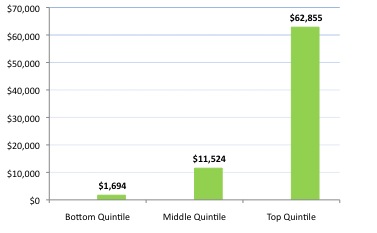What Contributes to Income Inequality in Mississippi?
November 29th, 2012
A new report from the Center on Budget and Policy Priorities examines income inequality in the states. They looked at total income differences among bottom, middle, and top income groups as well as the rates of income growth among those income groups. The first post in our series showed the percent increase in household income by income group in more recent years . The figure below shows what families of different income levels have experienced over the longer term (from 1970s to mid 2000s). The top quintile of households has seen a 75% increase in their income with an average increase of just over $60,000. Average income growth for the middle quintile was a much more modest 33% growth (about $11,000), and growth for the bottom quintile was only 13%, or $1,700.
Income Growth in for Mississippi Households by Income Group (1970s to 2000s)
Source: Center on Budget and Policy Priorities and the Economic Policy Institute, “Pulling Apart: A state-by-state analysis of income trends, November 2012
Why have incomes for Mississippians grown at such disparate rates? Some of the contributing factors are outlined below.
Factors Contributing to Income Inequality in Mississippi
- Wages have remained stagnant. Mississippi’s median hourly wage for workers has not changed substantially in the last 10 years and is below the Southern average.
- Education attainment affects family income and connecting more adults with education is a significant challenge in Mississippi. Over 500,000 Mississippi adults do not have formal education beyond high school, and over 350,000 of those Mississippians lack a high school degree.
- Manufacturing, traditionally a sector that pays quality wages for workers without higher education, has declined in employment in Mississippi. Since 2000, Mississippi’s greatest job losses have been in the manufacturing sector. From 2000 to 2011, Mississippi lost over 88,000 jobs in manufacturing, a decline of 39%.
- High unemployment in the state means employers are under less pressure to raise wages to attract workers. Mississippi lost 5.5% of available jobs from 2000 to 2011, resulting in an unemployment rate above the Southern average. The latest jobs numbers show Mississippi with a 9.2% unemployment rate, which is higher than the national unemployment rate (7.8%) and higher than our neighboring states.
- Conversely, employers who are looking for highly skilled employees must raise wages to attract the high skilled workers. Thus, wages for higher income households would increase. Wages for Mississippians with a bachelor’s degree ($21.26) were 1.8 times as much as workers with a high school degree ($11.77) last year.
- High skilled workers- those with a bachelor’s degree or higher- experienced much greater job stability in the 2007 recession than those with only a high school degree. Unemployment for adults with a high school degree was double that of adults with a bachelor’s degree in 2011. Job stability means more continuity in income, and advancement in wages and position.
In the first post, we highlighted some policy recommendations for how the state can begin to address income inequality. Specifically, we addressed ways we can work together to help folks in the bottom and middle quintile move up the economic ladder. This is vital for the well-being of the families in our state as well as our economy.







